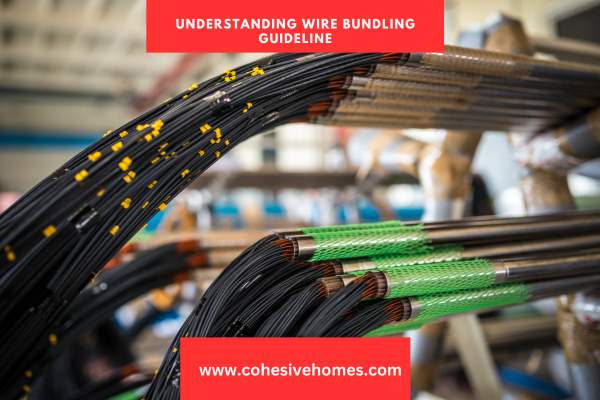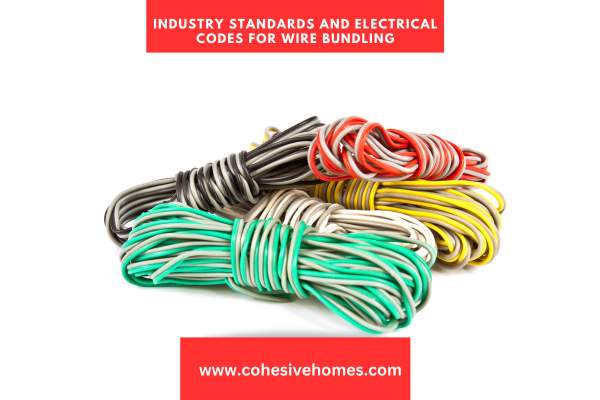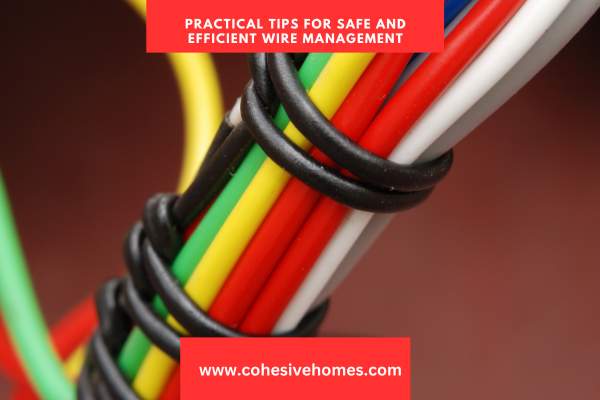Safety is paramount in electrical wiring, and understanding the guidelines for wire bundling is crucial. Romex wire, commonly used in residential and commercial applications, consists of multiple conductors enclosed in a protective sheath. In this blog post, we will explore the maximum number of Romex wires that can be safely bundled together, providing essential knowledge for safe and efficient wire management.
Join us as we uncover the guidelines and regulations to ensure secure electrical installations.
Understanding Wire Bundling Guidelines

When it comes to bundling Romex wires, it is crucial to adhere to certain guidelines to ensure safety and efficiency.
The National Electrical Code (NEC) provides recommendations for wire bundling to prevent issues such as excessive heat buildup and voltage drop.
The NEC generally suggests bundling Romex wires of the same gauge and insulation type together.
Consult NEC guidelines and local codes for specific Romex wire bundling limits based on wire size and environmental conditions.
Proper wire bundling is essential to maintain a suitable operating temperature and prevent overheating.
Overcrowding wires within a conduit or junction box can restrict airflow, leading to increased heat levels and potential fire hazards.
Follow NEC guidelines and local codes to determine proper Romex wire bundling capacity for safety.
By doing so, you can ensure compliance with safety regulations and maintain a reliable electrical system.
Remember, wire bundling guidelines are in place to safeguard against hazards and maintain the longevity of your electrical infrastructure. Understanding these guidelines and consulting with a qualified electrician when needed will help you make informed decisions regarding the bundling of Romex wires.
By prioritizing safety and following the recommended practices, you can create a secure and efficient electrical setup in your home or workplace.
Factors Influencing Romex Wire Bundling Capacity

Several factors come into play when determining the bundling capacity of Romex wires.
These factors can vary depending on the specific electrical installation and local regulations.
Here are some key factors that influence the maximum number of Romex wires that can be safely bundled together:
Wire Size and Gauge
The size and gauge of the Romex wires directly impact their bundling capacity.
Thicker wires generate more heat, so they may require more space for proper heat dissipation.
Smaller gauge wires have higher current-carrying capacities, allowing for more bundled wires within a given space.
Refer to NEC guidelines and wire size charts to determine proper bundling capacity for different wire sizes.
Ambient Temperature
The temperature of the environment where the Romex wires are installed is an essential factor.
Higher ambient temperatures can impact the heat dissipation capability of the wires.
In hotter conditions, bundling fewer wires may be necessary to prevent overheating.
It is crucial to consider the wires’ location and any potential heat sources that can affect their performance.
Insulation and conduit
The type of insulation used on the Romex wires and whether they are installed within a conduit can influence the bundling capacity.
Different insulation materials have varying heat-resistance properties. Wires with thicker insulation may require more space for proper heat dissipation.
Similarly, when Romex wires are installed within a conduit, the available space within the conduit must be considered when determining the number of wires that can be bundled together.
By taking these factors into account, electricians and DIY enthusiasts can make informed decisions about the maximum bundling capacity of Romex wires.
Industry Standards and Electrical Codes for Wire Bundling

Electrical codes and industry standards are essential to guaranteeing safety and compliance when it comes to wire bundling. When bundling Romex wires, electricians and homeowners must adhere to the standards and ordinances that offer recommendations and requirements. Consider the following important industrial standards and codes:
- National Electrical Code (NEC): The NEC is a widely recognized standard that sets forth regulations for electrical installations in the United States. It provides guidelines for wire bundling, including maximum fill capacities for conduit and requirements for maintaining proper wire spacing. The NEC offers valuable information on wire gauge, insulation types, ambient temperatures, and other factors to determine the safe bundling capacity of Romex wires.
- Local Electrical Codes: In addition to the NEC, local jurisdictions often have their own electrical codes that further define requirements for wire bundling. These codes may include additional provisions or variations based on regional factors such as climate, construction practices, and specific safety considerations. It is essential to consult the local electrical codes applicable to your area to ensure compliance with the specific regulations governing wire bundling.
- Manufacturer Recommendations: Romex wire manufacturers often provide specific guidelines and recommendations for bundling their products. These recommendations may include information on maximum fill capacities, temperature ratings, and best practices for wire management. It is important to refer to the manufacturer’s documentation and follow their guidelines to maintain the integrity and safety of the Romex wires.
Individuals can make sure that their wire bundling techniques satisfy the appropriate safety requirements by following industry standards like the NEC and local electrical regulations.
If these regulations are not followed, electrical systems may become faulty, fire risks may increase, and there may be legal repercussions.
To maintain safe and legal wire bundling methods, electricians and homeowners should always remain current on industry standards and regulations.
Debunking Common Myths and Misconceptions

There are several myths and misconceptions surrounding wire bundling that can lead to unsafe practices.
It is important to debunk these myths and provide clarity on the facts to promote proper wire management.
Let’s explore and debunk some of the common myths surrounding wire bundling:
Myth: The number of Romex wires that can be bundled is solely determined by their physical size.
Fact: While the physical size of the wires is a factor, other considerations such as wire gauge, insulation type, ambient temperature, and local electrical codes also play a significant role in determining the safe bundling capacity. It is crucial to consider all these factors collectively to ensure compliance and safety.
Myth: As long as the wires fit within the conduit, bundling as many wires as possible is acceptable.
Fact: Prevent hazards: Follow NEC and local codes, avoid overcrowding wires in conduit, ensure proper airflow for safety.
Myth: Romex wires of any gauge can be bundled together without limitations.
Fact: Different wire gauges have different current-carrying capacities and heat dissipation capabilities. Bundling wires of different gauges together can result in an uneven distribution of the electrical load and an increased risk of overheating. It is important to bundle Romex wires of the same gauge to ensure proper performance and safety.
Myth: Wire bundling guidelines are unnecessary and overly cautious.
Fact: Wire bundling guidelines are established based on extensive research, safety standards, and real-world experience. These guidelines aim to prevent hazards such as excessive heat buildup, voltage drop, and fire risks.
Adhering to these guidelines is essential for maintaining a safe and efficient electrical system.
Promote accurate wire bundling practices: consult reputable sources, follow codes, seek professional advice for safety and compliance.
Practical Tips for Safe and Efficient Wire Management

| Practical Tips for Safe and Efficient Wire Management |
| 1. Follow industry standards and local electrical codes for wire bundling. |
| 2. Use wire management tools such as cable ties, clips, and conduits to organize and secure wires. |
| 3. Avoid excessive bending or sharp turns in wires to prevent damage to insulation and ensure proper conductivity. |
| 4. Leave sufficient space for airflow around bundled wires to dissipate heat effectively. |
| 5. Label wires and create a comprehensive wiring diagram or color-coding system for easy identification and maintenance. |
| 6. Avoid overloading electrical conduits or junction boxes beyond their maximum fill capacities. |
| 7. Routinely inspect and maintain wire connections, ensuring they are secure and free from damage or corrosion. |
| 8. When making wire connections, use proper techniques such as stripping insulation to the correct length and using appropriate wire connectors. |
| 9. Consider future expansion or modifications when planning wire management to accommodate additional wires or changes in the electrical system. |
| 10. When in doubt, consult a qualified electrician for guidance and assistance with wire management and installations. |
You may assure the efficient and safe management of wires in your electrical installations, enhancing dependability and lowering the possibility of dangers or malfunctions, by putting these useful ideas into practice.
Conclusion

Proper wire bundling is a critical aspect of electrical installations, ensuring safety, efficiency, and compliance with industry standards and electrical codes.
You can build a secure and trustworthy electrical system by being aware of wire bundling rules, taking into account variables that affect bundling capacity, and adhering to useful wire management advice.
Throughout this blog post, we have debunked common myths and misconceptions surrounding wire bundling, providing accurate information to promote responsible practices.
It is important to rely on reputable sources, consult industry standards such as the NEC, and adhere to local electrical codes to ensure the safety and compliance of wire bundling.
Remember, electrical safety is a collective responsibility.
By following proper wire bundling techniques, including using appropriate wire management tools, maintaining adequate spacing, and regularly inspecting wire connections, you can minimize the risk of hazards and ensure the longevity of your electrical infrastructure.
Whether you are a professional electrician or a homeowner handling DIY projects, prioritizing safe and efficient wire management is essential.
If you ever feel unsure or encounter complex electrical installations, do not hesitate to seek assistance from a qualified electrician.
You can confidently handle wire bundling jobs and help create a safer and more dependable electrical system in your home or place of business by putting the knowledge and helpful hints from this blog post to use. In all your wire management efforts, keep yourself informed, compliant, and electrical safety top of mind.
FAQS
How many Romex wires can be safely bundled together?
The maximum number of Romex wires that can be safely bundled depends on factors such as wire gauge, insulation type, and local electrical codes.
Can Romex wires of different gauges be bundled together?
Experts generally recommend bundling Romex wires of the same gauge together for optimal performance and safety.
Can Romex wires be bundled within a conduit?
Yes, you can bundle Romex wires within a conduit, but it’s crucial to follow the recommended fill capacities to ensure proper heat dissipation and prevent hazards.
